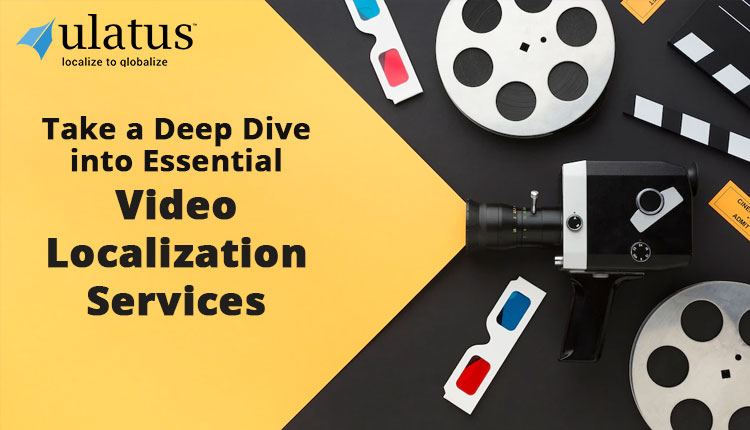Take a Deep Dive into Essential Video Localization Services
With countless hours of video content being published online every day, it is becoming considerably more difficult to ensure that your video will stand out. As such, attracting viewers is a challenge, especially on a global level.
If you want your content to captivate the international audience, it is time to localize your video. Read on to learn about subtitles, voiceovers, and dubbing; which are three of the best ways to localize your video’s content for your target audience.
Subtitles: A Cost-Effective Approach
Subtitles are lines of translated dialog text that appear at the bottom of the screen. The translated text is added as a way for viewers to watch the video with the original sound, although they do not understand the language. While creating subtitles is time consuming, machine translation tools will help make the process more efficient.
As people increase the amount of time they spend watching videos, subtitles are becoming increasingly more popular. The primary advantages of subtitles include:
- They provide viewers with flexibility: Viewers enjoy having subtitles available, even if they speak the original language, particularly because the captions provide a means to watch videos in quiet places.
- Subtitles enhance search engine optimization (SEO). A great aspect of subtitles is that they provide many opportunities to generate SEO, which helps viewers locate the videos.
- They are a cost-effective option. For many businesses, subtitles are a more affordable option than voiceovers and dubbing. When seeking a subtitling translation services company, ask for a detailed price quote so you can make certain that the project remains within your localization budget.
Although subtitles have several benefits, there are some important aspects to consider if you decide to use them, including:
- Being prepared for text expansion: One of the biggest challenges with subtitling is that the text can expand when it is translated into other languages. As such, subtitles can distract viewers, especially if there are other text elements on the screen. To address this issue, the text might need to be modified, while ensuring that the intended meaning remains the same. A subtitle translation agency will make certain that the subtitles are written concisely without changing the original intent of the text.
- Thinking about length and spacing: Another issue with subtitles is that the video layout must allow for proper length and spacing of the lines of text. As much as possible, subtitles should appear as a maximum of two lines at one time. By following this guideline, viewers can see the text without feeling overwhelmed. Additionally, it is important to select the right number of characters per line; that decision will depend on the target language and how much space it needs.
- Focusing on timing: If the subtitle timing is not synchronized correctly, it will defeat the purpose of the text. A subtitle should appear on the screen when the speaker begins talking, then it should stop right after the speaker is done.
- Translating to relay intent rather than precise words: Because of the limitations of subtitles, the translator needs flexibility when conducting the translation. When working with subtitles, retaining the tone and the message’s intent is more important than precisely translating specific words. Therefore, the translator might have to select different words in the target language to maintain the original meaning of the dialog.
Voiceovers: Localization Through Narration
Voiceovers involve a narrator being recorded while reading a script, then the recording being added to the video. Because of their overall nature and tone, voiceovers are generally more suitable for documentaries and educational programs, rather than for entertainment or marketing content.
The benefits of voiceovers include:
- They provide context about the video: Having a narrator speak during the video gives the viewers context around some of the content they are seeing. Therefore, voiceovers improve viewers’ understanding of the video’s messaging, which helps ensure an improved viewing and learning experience. This context makes the videos more enjoyable for international
- The narration enhances the storytelling: Oftentimes, a video includes narration to enrich the storytelling, which also keeps viewers engaged. In addition, voiceovers help viewers relate to the video’s content, while providing some clarity around a topic.
- Voiceovers effectively relay messages: By using voiceovers, companies can relay messages in an effective and straightforward way. The narration ensures that the correct tone is set, and the message is given in the way the business intends, instead of leaving it open to interpretation.
Some considerations with voiceovers include:
- Finding the right voice talent: Locating the right voice talent is essential to how the audience will perceive the video. Think about the type of personality and voice that you want reciting the script. Careful vetting of potential narrators by a voiceover translation agency will ensure that the best talent is selected.
- Deciding the tone of the narration: Voiceovers are typically more straightforward in their presentation, especially when compared to dubbing. However, consideration should be given about what tone the narrator should use. For example, think about whether you want the speaker to communicate professionalism and expertise or express emotions, such as happiness and excitement. This decision will be affected by the expectations of the target audience.
- Making certain that words are pronounced in the right language. Some words in the script might be difficult to translate, including proper nouns, acronyms, and product names. Although it might seem like a small detail, it is important to decide in advance whether certain words should be pronounced in the source or target language.
- Thinking about the best talking speed. For the video to be effective, the speaking must occur in just the right speed. As an example, a technical video requires clear articulation and a slower speaking speed, whereas other videos might need a faster delivery.
- Allowing flexibility in script translation. The localized video script will likely run shorter or longer than the original version. As such, script translators need some leeway to adapt the script to suit the timing in the video. To feel confident in the translators’ abilities, partner with a voiceover translation services company that has native speakers of the languages available to work on your project.
Dubbing: Portraying Characters in the Target Language
Although dubbing is the most expensive and complex of the three localization options, it is an excellent way to ensure that the video effectively connects with the target audience. During the dubbing process, voice actors will be recorded reciting the script, then the translated dialog will replace the original video sound. Although viewers like reading subtitles, there are still countless people who enjoy hearing their own language as they watch a video.
The benefits of dubbing include:
- It retains the original meaning: Because dubbing uses the original actors with translated dialog, the objective of the video remains intact. It also ensures that the scenes are played out as they are meant to, since the only major change is with the language replacement.
- Dubbing keeps viewers interested: Some people simply do not want to be distracted by having to read subtitles to understand what is being said. With dubbed content, viewers can concentrate on the entire video without dividing their attention between text and what is happening on the screen.
- Characters are accurately portrayed: Dubbing helps develop characters that people feel a connection to, and it allows the complexities of characters’ personalities to become more obvious.
Some of the primary considerations with dubbing are:
- Hiring the right voice talent: Similar to the requirements of voiceovers, finding the right voice talent makes a huge difference in the success of the localized video. However, dubbing requires a higher level of talent, because the voice actors have to portray the characters in a manner that is similar to the work of the original actors.
- Translating the script and adjusting the timing: Because dubbing entails recreating the video’s dialog in the target language, the entire script must be translated. After this step is complete, the translated dialog will be synchronized with the original audio to make it look like the actors are speaking the lines. Because of the complexities involved, translation for dubbing requires a native speaker to be involved in the translation process.
- Using a professional recording studio: Because all the dialog will need to be recorded in the target language, it is best to use a dubbing translation agency to make certain that the recording runs smoothly.
- Allowing plenty of time for editing: One of the most critical aspects of the dubbing process is the editing and layering stage. During this phase, editors work to converge the new recordings and dialog tracks with the original video sound. Because this work is very technical, it is essential to contract with a video localization agency to conduct the editing
Which Option is Right for Your Video?
All these options are excellent choices for your video localization project, so deciding on which ones to use can be difficult. As you think about the decision, consider the following factors:
- Target market:When deciding which localization techniques to use, the first step is to think about what would appeal most to the target audience. For instance, if viewers in the region seem to prefer dubbed videos, then that should be one of your primary considerations. This information can be discovered by conducting market research about the target audience.
- Goals of the video: After you have defined the video’s objectives, it will become clearer as to which method will work best. If your video is educational, voiceovers will be a good choice. Alternatively, if the purpose of the content is to entertain viewers, dubbing or subtitles will be a better option.
- How the video will be displayed: Another essential consideration is how viewers will be watching the video. If they are more likely to watch it on their smart phones, instead of televisions, you might select an option that is better suited to those devices. Again, market research will help determine the best option based on users’ viewing patterns.
- Complexity of the video’s content: If your video contains highly specialized content, then dubbing will likely not be a good fit. Additionally, if the content includes several written elements, then subtitles might be overwhelming to viewers.
Work With a Language Services Provider
After thinking about the right localization strategy for your company, it is time to find a professional language services provider (LSP). To find the best agency, seek an LSP that offers the following:
- It specializes in all three options. Whether you choose one of the services or all three, you should not be hindered by an LSP’s limitations. The agency should have the expertise to accommodate all your requirements.
- The LSP offers numerous language combinations: From common languages to rare ones, the LSP should be able to offer just about any language requirement you have. Make sure that the video subtitling services agency can meet future language needs as well.
- The agency will manage all aspects of the project: When you are embarking on localization, your LSP should manage every part of the project, from developing a timeline and list of deliverables to releasing your video to the new market.
- It provides other localization services: Your localization strategy should be uniform across all services; as such, find an LSP that can localize other aspects of your business, such as your website and other marketing tools.
The video localization process can seem daunting, especially when you are faced with critical decisions that will affect the outcome of your video. By partnering with a video localization agency that specializes in subtitles, voiceovers, and dubbing, you will be able to develop a strategy that works best for your company. When the final localized video is successful in its market, the investment will have been worth it.
Summary
When localizing your video, there are many techniques to use; the three primary ones are subtitles, voiceovers, and dubbing. Each service has its advantages and challenges and knowing which one to select can be difficult. Read our deep dive into all three options to help you choose the right one for your video localization project.






Share your thoughts